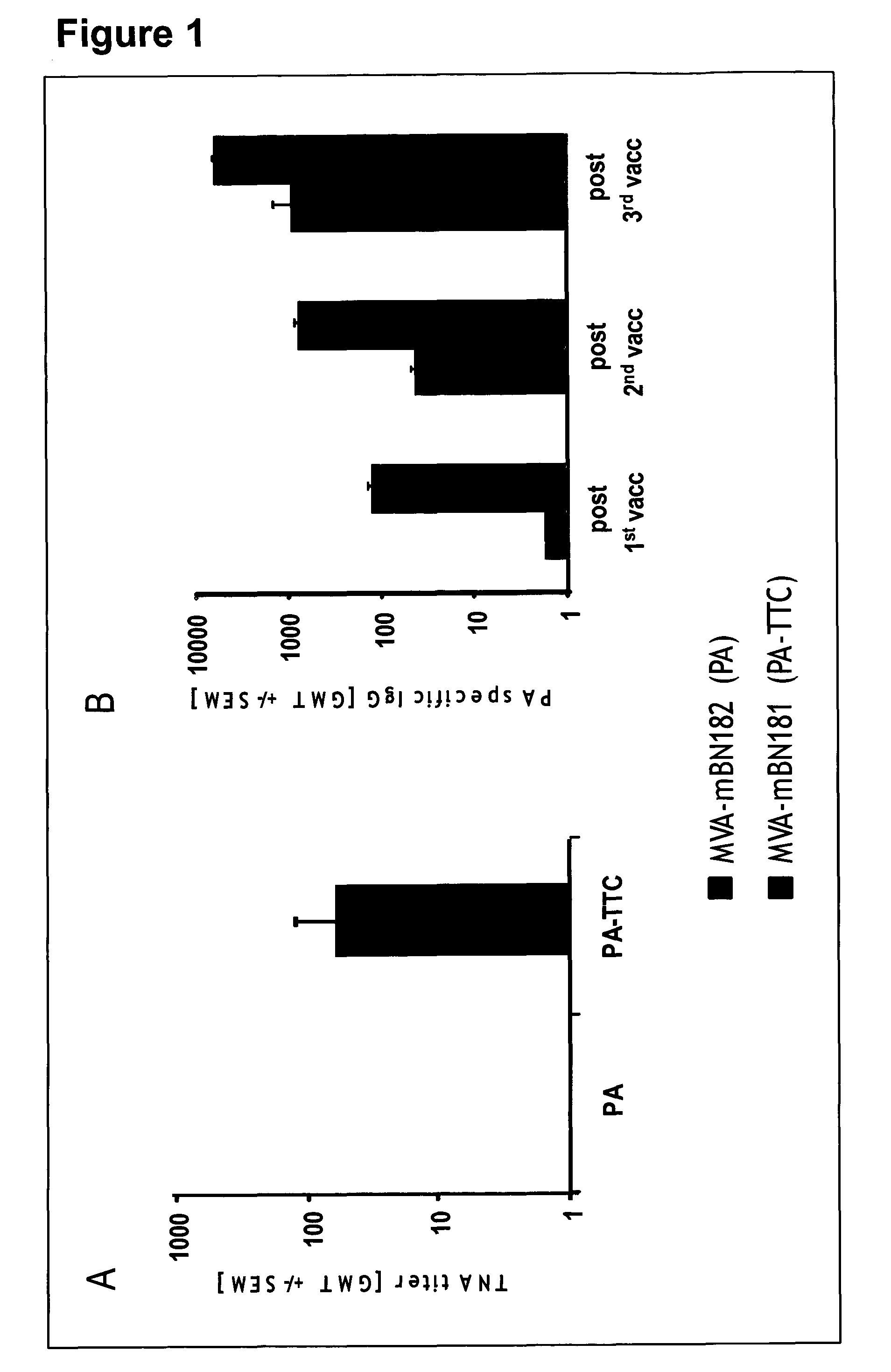Recombinant poxvirus vector comprising tetanus toxin fragment C
a poxvirus and fragment technology, applied in the field of recombinant poxvirus vector comprising tetanus toxin fragment c, can solve the problems of uncontrollable muscle contraction, pain, and difficulty in obtaining a sufficient and neither is known nor believed to be possible to increase an immune response against an antigen
- Summary
- Abstract
- Description
- Claims
- Application Information
AI Technical Summary
Benefits of technology
Problems solved by technology
Method used
Image
Examples
example 1
Recombinant Poxvirus Vector Comprising PA-TTC Sequence
[0244]A recombinant plasmid containing the sequence for a PA or PA variant, such as PA83, PA63, PA47, PA furin negative or other PA mutants (such as described in Table 2), along with a promoter sequence. For integration into the genome of modified vaccinia virus Ankara suitable flanking sequences are, e.g., DNA sequences adjacent to the intergenic region IGR 64 / 65 or IGR 148 / 149 that can be introduced in a suitable vector. For an improved secretion of expressed antigens, vectors can include appropriate leader sequences that encode secretion signals. For example, a suitable vector could be the pSecTag2 vectors (Invitrogen, Carlsbad, Calif., USA), containing a 21 AA amino-terminal secretion sequence SecTag2 from the V-J2-C region of the mouse Ig kappa-chain (METDTLLLWVLLLWVPGSTGD; see SEQ ID No:1 or 2) which can be used for an efficient secretion of recombinant proteins. The sequence is N-terminally fused to the antigen sequence (s...
example 2
Construction of MVA PA-TTC
[0248]The PA83 gene was chemically synthesized by GENEART AG (Regensburg, Germany) with a codon usage optimized for expression in humans. The adaptation of the codon usage included the removal of sequence elements, which could disturb viral and eukaryotic transcription and expression (e.g. six premature polyadenylation sites, premature stop signals for early transcription, RNA instability motifs and long G / C rich stretches.) The PA amino acid-sequence (735AA) of the recombinant MVA lacks the bacterial secretion signal (29 AA) and is 100% identical to the corresponding part of the translated pagA amino acid-sequence, thus making it identical to AA 30-764 of the sequence deposited under NCBI accession number AAF86457.1. For secretion of the PA protein in mammalian cells, a 21 AA amino-terminal secretion sequence (SecTag2; Ig kappa-chain leader sequence, from plasmid pSecTag2, Invitrogen) was N-terminally fused to the PA gene.
[0249]Similarly, instead of PA83, ...
example 3
Construction of MVA-PA+LF
[0252]An LF variant, a truncated Lethal Factor of B. anthracis, was used for the construction of recombination plasmid. SecTag2 was N-terminally fused to the LF34-583(ΔLF) sequence, an inactive form of the LF protein. Alternatively, other LF7, LF50, LFE687C or other variants such as shown in Table 2 can be used. The LF34-583 was chemically synthesized by GENEART AG (Regensburg, Germany) with a codon usage optimized for expression in humans. The LF34-583 gene lacks the bacterial secretion signal and is identical to NCBI accession number AAR88322.1. PrS-SecTag2-PA83 (as in Example 2) and PrS-SecTag-LF34-583, flanked by MVA DNA sequences adjacent to the IGR148 / 149 site, were inserted into a suitable recombination plasmid which additionally contains a loxP-flanked selection cassette. Primary CEF cells were infected with MVA and subsequently transfected with the recombination plasmid. For excision of the selection cassette, expression plasmid encoding the Cre-rec...
PUM
| Property | Measurement | Unit |
|---|---|---|
| temperatures | aaaaa | aaaaa |
| temperatures | aaaaa | aaaaa |
| temperatures | aaaaa | aaaaa |
Abstract
Description
Claims
Application Information
 Login to View More
Login to View More - R&D
- Intellectual Property
- Life Sciences
- Materials
- Tech Scout
- Unparalleled Data Quality
- Higher Quality Content
- 60% Fewer Hallucinations
Browse by: Latest US Patents, China's latest patents, Technical Efficacy Thesaurus, Application Domain, Technology Topic, Popular Technical Reports.
© 2025 PatSnap. All rights reserved.Legal|Privacy policy|Modern Slavery Act Transparency Statement|Sitemap|About US| Contact US: help@patsnap.com



